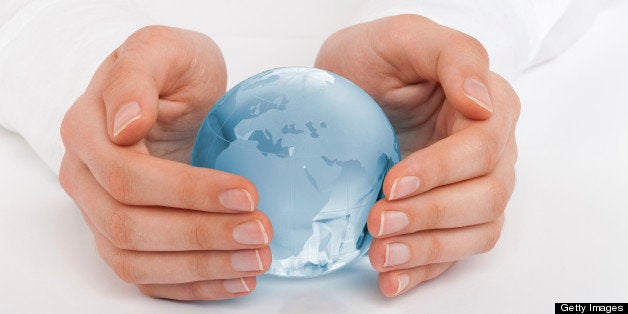
Today is Earth Day, the 43rd year the United States has dedicated a day to the planet we can't live without. So what's changed since 1970? I'd like to think fashions have improved -- you won't catch me wearing denim bell bottoms or butterfly collars these days. And you won't find too many people praising that decade's architecture -- Washington, D.C.'s hulking concrete FBI Building comes to mind.
Many of the environmental challenges we faced at that first Earth Day have also improved. Rivers, for example, aren't catching on fire any more. But others haven't changed as much. Wealthy countries, like our own, are still using a disproportionate share of the Earth's resources.
On this Earth Day, while we talk about reducing emissions and shifting to renewable sources of energy, we also need to focus on family planning. Family planning is one of the most important investments we can make for the global environment.
The world's population has almost doubled -- from 3.7 billion on the first Earth Day in 1970 to just over 7 billion today. That's a whole lot of people. But does it matter? It depends on the type of life we all want to live.
There's no hard and fast limit to how many people the Earth can support. According to the Global Footprint Network, if everyone lived like people in Bangladesh, the Earth could comfortably accommodate perhaps even 21 billion people. But we don't all live like Bangladeshis. If everyone lived like we Americans do, we'd need more than four Earths to support our consumption.
Meanwhile, the real life population keeps on growing. The youth of today are the largest generation in world history, and the choices they make will affect what our planet looks like in the years ahead. The United Nations projects a world population of anywhere from 8.1 billion to 10.6 billion in 2050 -- only 37 years from now.
Some critics like to laugh at those of us who talk about population growth. They call us names like "neo-Malthusians" and argue that resources are infinite and that economic growth depends on an ever-expanding human population. They say that technology will solve all our problems.
But do we really want to rely on "we'll figure something out" when real people's lives are at stake?
Here's where we stand on Earth Day 2013: One in every eight people are already hungry. Climate change's effects on the environment are expected to double food prices by 2050. In places where people live on less than $2 per day and spend a larger percentage of their income on food, that spike would spell disaster.
Water resources are also tight. Sure, our planet may be covered in water, but only 2.5 percent of that water is fresh. Around 1.2 billion people live in areas where water is scarce. By 2025, half the people around the globe are expected to live in areas of water stress.
And we're not the only living beings on this planet. When human populations expand, they can crowd out plants and animals. Loss of land to development can force animals out of their territories and destroy plant biodiversity.
Slowing down population growth won't single-handedly solve the problems of hunger, water scarcity and biodiversity loss -- but it would help reduce the pressures on natural resources. Even more importantly, it would improve the quality of life of some of the world's poorest people, allowing them to rise out of poverty and enjoy things most of us take for granted.
To truly change the world, invest in women. When women have the ability to plan their families, the benefits reverberate through entire societies. Moms are healthier, and children are, too. Girls and women are more likely to be educated when they can access contraception. When girls and women are educated and active in their communities, they boost entire economies. And it will help families and communities be more resilient to the problems that climate change is already causing.
This is our Earth Day wish: $1 billion for international family planning programs. Two hundred and twenty million women around the world want to avoid pregnancy but don't have access to modern contraception. This investment is America's fair share of making sure these women can have children when they want to -- and avoid pregnancy when they don't. It's not just good for the planet. It's the right thing to do for people, too.
1970 might seem like a long time ago, and a lot of things have changed. But 43 years later, we still need Earth Day. And though we hardly ever hear about it, we still need to talk about population. Because this planet -- for now, at least -- is the only one we've got.
John Seager is President of Population Connection, the nation's largest grassroots population organization. The organization's website is populationconnection.org.